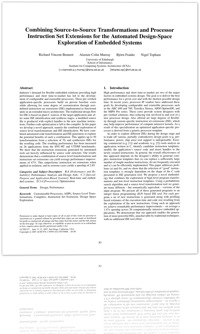Combining Source-to-Source Transformations and Processor Instruction Set Extensions for the Automated Design-Space Exploration of Embedded Systems
-
Abstract:
Industry's demand for flexible embedded solutions providing high performance and short time-to-market has led to the development of configurable and extensible processors. These pre-verified application-specific processors build on proven baseline cores while allowing for some degree of customization through user-defined instruction set extensions (ISE) implemented as functional units in an extended micro-architecture. The traditional design flow for ISE is based on plain C sources of the target application and, after some ISE identification and synthesis stages, a modified source file is produced with explicit handles to the new machine instructions. Further code optimization is left to the compiler. In this paper we develop a novel approach, namely the combined exploration of source-level transformations and ISE identification. We have combined automated code transformation and ISE generators to explore the potential benefits of such a combination. This applies up to 50 transformations from a selection of 70, and synthesizes ISEs for the resulting code. The resulting performance has been measured on 26 applications from the SNU-RT and UTDSP benchmarks. We show that the instruction extensions generated by automated tools are heavily influenced by source code structure. Our results demonstrate that a combination of source-level transformations and instruction set extensions can yield average performance improvements of 47%. This out performs instruction set extensions when applied in isolation, and in extreme cases yields a speedup of 2.85.




